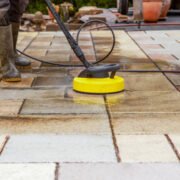Unless you live in a warm place, where swimming is possible all year round, you have to winterize your pool to protect it during the frosty winter months. The objective of winterizing your pool is to prevent any damages from frozen water or snow.
If you take care of your pool now, you’ll have much less work to do to prepare your pool for heavy-use in summers. The harsh winters of places such as Colorado can damage your pool to a certain extent that it may require repair or even replace your pool.
Even a minor pool repair could be expensive, burning a big hole in your pocket.
To prevent this from happening or to limit the possibility, at least, winterizing your pool is indispensable. So, here, we’ve curated a mini-guide on how to winterize your pool properly.
Step 1: Clean the Pool
First of all, you need to eliminate all the existing water problems such as cloudiness or algae, with proper water treatment. Get rid of the debris such as pine needles, leaves, and errant twigs, thoroughly vacuum your pool, and carefully brush the sides. Check the Ph levels; it has to be between 7.2 and 7.6 ppm.
The lower the Ph value of water is, the more acidic it is. You can adjust the Ph with the use of increasing and decreasing agents. You need to check for alkalinity during the months of use; it must be between 80 to 125 ppm, while around 150ppm for the offseason. Make use of acid slowly to reduce the alkalinity of the pool.
Check for the hardness of the pool; it has to be around 200-250 ppm. Hard water will lead to a greater deposit of calcium, whereas soft water will absorb calcium from the pool, leading to the damage. Add a dosage of algaecide to prevent the growth of algae during the winter months.
And, finally, clean the pool. Pump out the pool water and remove leaves and debris.
Step 2: A Pool Cover
A pool cover or pool enclosures are a worth addition during the no-use months. They offer a myriad of perks:

Added Security
Your naughty kids won’t be able to put his/her life in danger by jumping into the pool water.
Block Debris
Less cleaning is required when the summer arrives.
Prevent Damage
Covering your pool is important to protect your pool during the colder weather, making it less likely to develop cracks than when the pool is without a cover.
The pool covers are broadly divided into three categories:
Mesh Safety Covers:: A mesh cover will protect your pool water from debris, and the tiny meshes will allow your pool to breathe, let the rain droplets and snow to drain into your pool.
Solid Safety Covers: The solid pool covers are available in various color options and far more aesthetically appealing. But, it does allow the water to accumulate on top of the pool.
Automatic Pool Covers: We have the technology that allows us to cover and uncover the pool with a flick of a switch.
Step 3: Winterize the Equipment
Remove the pool’s hoses, pump, chlorinator, and any other pool equipment. Then, you must remove all the drain plugs for completely draining the equipment. If there are cartridge filters, then drain it.
After that, rinse off the cartridge with tap water or water, and carefully store it indoors. The DE filters must be properly drained.
Step 4: Store the Accessories
These accessories include the poles, skim baskets, chlorine tablet containers, and brushes. Freezing outside temperature will certainly shorten the lifespan of plastic materials.
The most key aspect of winterizing your pool is to clean the pool water of any debris and then install the snug-fit pool cover after you have complete peace of mind and wait for the summers to arrive.
Do you have some tips to share with our readers? Feel free to share in the section below.












